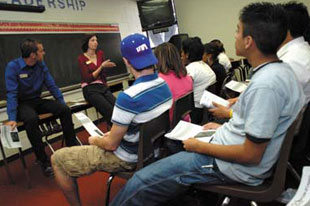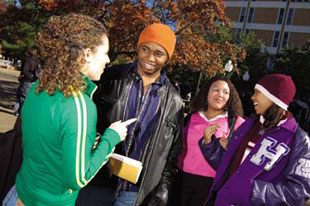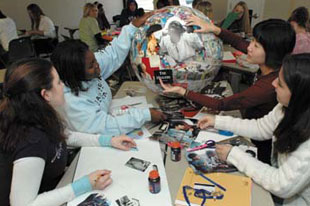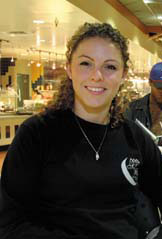| Q&A with UTA's oldest living graduate | Alumni as college presidents | Recognition of contributors |
 |
||
| Home Forethought Campus Buzz Feature Stories Re:Search The Score Alum News Yesteryear | ||
 |
 |
 |
Next, Kyser would return to her room in Kalpana Chawla Hall, where she lived alongside these same students. Soon they’d be off to history class. Then lunch, afternoon classes, evening study sessions and frequent late-night food runs or shopping excursions.
The camaraderie helped smooth the transition to a university more than 20 times the size of her hometown.
“We spend pretty much all of our time with the group,” said the communication major from Johnson City in the Texas Hill Country. “They help you with problems and are there to make your adjustment a little easier.”
Kyser’s circle of friends is the Leadership Commonwealth freshman interest group, one of nine FIGs, as they’re called, introduced at UTA last fall to enrich the learning environment for students living on campus.
FIG members are group housed in KC Hall according to academic interest, and they take several courses together. They have access to faculty mentors and to upper-class peer counselors who advise and tutor them.
National studies have shown that such living/learning arrangements improve retention and graduation rates, build a sense of community and increase interaction among faculty and students. The idea is to bring education from the classroom to the residence hall.
Communities of learning
Students living together in learning communities can be traced to the philosophies of educators Alexander Meiklejohn and John Dewey in the 1920s. Meiklejohn created the Experimental Program at the University of Wisconsin, which required students to take a set sequence of courses over two years. Dewey viewed learning as a social process and emphasized collaboration among students.
 |
DANNY GROSS FIG: HEALTH PROFESSIONS MAJOR: biology HOMETOWN: Shallowater ON HIS FAVORITE ASPECT OF KC HALL |
In the 1960s, University of California, Berkeley Professor Joseph Tussman took the concept a step further. Called the Experiment at Berkeley, Tussman organized students into cohort groups that took predetermined sets of courses team taught by faculty. The Experiment at Berkeley is widely considered the forerunner of today’s learning community programs.
More recently, Evergreen State College in Olympia, Wash., added the National Learning Communities Project, which helps other higher education institutions develop their own programs. UTA is in the organization’s Southern Region.
Although this is the first year for residential FIGs at UTA, the Office of Student Success Programs launched the Maverick Scholars in 1997 to help boost retention and graduation rates. The program has promoted student success through nonresidential learning communities for more than 1,100 students.
“We tend to see a 5 to 10 percent higher retention rate from fall to fall compared to other students,” Student Success Programs Director Dawn Remmers, whose office oversees the FIG program, said of Maverick Scholars. “We also tend to see a 10 percent difference in graduation rates.”
 |
MAY ZHOU FIG: NURSING: AN ART AND A SCIENCE MAJOR: nursing HOMETOWN: Houston ON GROUP'S INCLUSIVENESS |
The success of the nonresidential program led UTA to introduce a pilot program in fall 2002 for students living on campus. The University’s first residential learning community featured Honors College and engineering students enrolled in common courses and aided by peer counselors trained and funded by Student Success Programs.
Again, results were positive. The one-year retention rate and grade-point average for the community were much higher than those of other first-year UTA students. Encouraged by the upswing, the University established three more living/learning communities in Arlington Hall a year later.
Sample a FIG
Kalpana Chawla Hall opened last fall as UTA’s first residential learning center. All 421 students in the hall—named for the UTA alumna and astronaut who died in the space shuttle Columbia accident—live in one of eight learning communities: business, nursing, science, engineering, leadership, social science, liberal arts, and fine arts and architecture.
Embedded within the learning communities are the nine FIGs. For example, the Health Professions FIG is part of the science learning community, and the pre-law FIG is under the umbrella of the liberal arts community.
 |
KRISTIN KYSER FIG: LEADERSHIP COMMONWEALTH MAJOR: Communication HOMETOWN: Johnson City ON THE GROUP'S CAMARADERIE: |
Most FIGs contain 10-20 students. Each group has a coordinator, one or two faculty mentors and one or two peer counselors.
Coordinators, who usually come from the unit’s advising or student affairs areas, oversee the FIG. Their responsibilities include assembling a resource team, monitoring student academic progress and helping with marketing and recruitment. They also create co-curricular activities.
For the World of Business FIG, coordinator Andy Axsom supplemented his group’s classroom experiences with current event luncheons, a business etiquette seminar and an ice cream-making event that required students to create a flavor and develop a marketing jingle.
“In one semester, these students not only became adjusted to the college environment, but they learned to excel both academically and personally,” said Axsom, a student development specialist in the College of Business Administration. “Now the task is to prepare them not only for their sophomore year but for future successes in their business courses and ultimately in the corporate world.”
 |
FRANK PERERA FIG: GREAT THINKERS MAJOR: mechanical engineering HOMETOWN: Arlington ON THE CONVENIENCE OF LIVING NEAR FELLOW FIG MEMBERS: |
Faculty mentors hold office hours in KC Hall for students who need academic guidance. They also attend their group’s co-curricular activities and often visit the college adjustment course that all FIG students are required to take.
“I worked at being accessible,” said nursing Clinical Instructor Alean Royes, a mentor for the nursing FIG. “I met with the students and dealt with their successes as well as their adjustment problems, including roommate problems, homesickness and studying.”
While faculty and staff participation is an integral part of the program, the rapport that FIG students develop with their peer counselors may be the most beneficial.
“It’s one thing when your students come to you for help in class, but it is really a good feeling when they trust you enough to come to you with personal concerns outside of class,” said Aris Hopkins, a peer counselor for the honors FIG. “Being a student teacher makes it easier for our students to talk to us about things other than academics. They know that two years ago we were taking the same class and living in the hall for the first time, so I think that makes them feel more comfortable with us.”
Living near their students in KC Hall is another huge advantage, Hopkins says.
“It’s easy for them to just walk across the hall and knock on our doors if they have questions about assignments.”
 |
MIA ROMANO FIG: LIBERAL ARTS PRE LAW MAJOR: political science and Russian HOMETOWN: Clear Lake ON THE SIGNIFICANCE OF KC HALL EXPERIENCE |
Making the adjustment
Peer counselors also teach the college adjustment course, a staple of the FIG experience. The class covers goal setting, time management, note taking, reading skills, test taking, money management and healthy lifestyles. In short, it helps freshmen make the leap from high school to a university.
“The class teaches us how to survive in college,” said honors FIG member Frank Perera.
Guest lecturers often speak to the classes. Last fall, the pre-law FIG heard liberal arts Associate Dean Kimberly Van Noort discuss career opportunities for liberal arts graduates. The honors FIG watched Ellen Myers of the Counseling Office demonstrate stress management techniques. Greg Bateson of the Health Center shared his wisdom on safe dating practices with Health Professions FIG members.
Sometimes the groups leave the classroom for a little hands-on learning. The Harbison Community FIG (for computer science and engineering majors) toured UTA’s MavPad, a sensor-filled smart home that learns about its inhabitants, responds to their actions and anticipates their needs.
 |
JONATHAN RUFFIN FIG: HARBISON COMMUNITY MAJOR: computer science and engineering HOMETOWN: Benbrook ON THE GROUP'S ACADEMIC BENEFITS: |
“The goal is for the students to leave their first semester not only academically successful but with the resources to determine what interests them outside the classroom,” said course administrator Janette Keen, a counseling specialist with Student Success Programs. “We want to make sure they have all of those connections that are going to make them want to stay.”
In addition to the college adjustment class, FIG members take at least two other courses together. This clustered scheduling is designed to help them develop friendships, form study groups and become comfortable in their learning environment. Recall Dewey’s theory that learning intensifies when students relate to each other as social beings.
“The biggest benefit of being in the FIG is that you get to meet lots of people who have the same interests as you,” said Ashley Williams of the business FIG. “You get a chance to meet people who can study with you and take many of the same courses.”
Professors see the advantages. Senior Lecturer Peggy Kulesz, who taught English to the nursing FIG last semester, says classroom discussion moved quickly to substantive issues without a breaking-in period.
 |
VERONICA GOMEZ FIG: EXPLORING CAREERS IN HUMAN SERVICES MAJOR: psychology HOMETOWN: Houston ON THE GROUP'S LONG RANGE BENEFITS |
“When students know one another well enough to feel comfortable together, they are more likely to speak honestly and thoughtfully in class,” she said. “I find that the FIG students are not so concerned with impressing one another because they have already maneuvered through those socialization steps as part of their living experience in the residence hall.”
So far, so good
FIG feedback has been positive—from faculty, staff, administrators and, most importantly, students.
“I can’t begin to tell you how the transition from high school to college was made easier by being in a FIG,” said the Leadership Commonwealth’s Sheena Odhwani. “The thought of moving from a high school with 2,000 students to a school 12 times as big was frightening. Being in a FIG, I got to meet people just as scared as I was and have a support system.”
Participants value the opportunity to be part of a coterie of academically focused peers.
“The nursing FIG has given me a sense of belonging to a community where you know everyone,” said May Zhou of Houston. “It is especially important to belong to a group in college because it helps you adjust to college life and helps decrease homesickness.”
 |
ERIC MCMILLAN FIG: WORLD OF BUSINESS MAJOR: accounting HOMETOWN: Pearland ON THE GROUP'S LUNCHEONS WITH BUSINESS EXECUTIVES |
Even with widespread acclaim for the program, Remmers is exploring ways to improve it. Next year’s FIGs will be organized differently, including the addition of a Global Thinkers group for students interested in international experiences and other cultures. The learning communities will have a new look as well.
“Ours is a well-thought-out model, but it has a lot of flexibility,” she said.
Also drawing high praise is KC Hall. Odhwani calls it “an amazing facility honoring an amazing person.”
Architects designed the three-story, $21 million structure as a residential learning center. Consequently, it features a computer lab and study lounge on each floor, plus classrooms and offices. The study areas are strategically located near elevators so students coming and going will see others cracking the books and, ideally, follow suit.
“We find that a lot of behavior is modeled,” Remmers said. “If residents see their peers studying and using this space, they’re going to study and use this space.”
The plan is working.
Kyser and her fellow FIG members frequent their second-floor study hall most evenings. And although she has her own computer in her room, she often walks from the study area to the adjacent computer lab to check her e-mail.
“Those late-night study sessions in the study lounge and the nights spent just hanging out are great,” she said.
Students love KC Hall’s amenities, but it’s the family atmosphere created by the learning communities that has made the biggest impact.
“The thing I like most about living in KC Hall is the people,” said Danny Gross of the Health Professions FIG. “I made so many friends so fast here.”
Ditto for Kyser.
“Friends are one of the things that make college life memorable,” she said. “I’ve already formed friendships that will last forever.”
— Mark Permenter
| Archives
| Alumni Association |
Giving to UTA | UTA
Home Copyright © 2005 UTA Magazine. All rights reserved. |